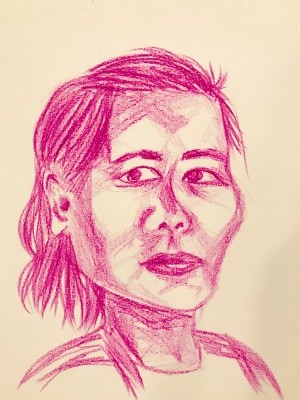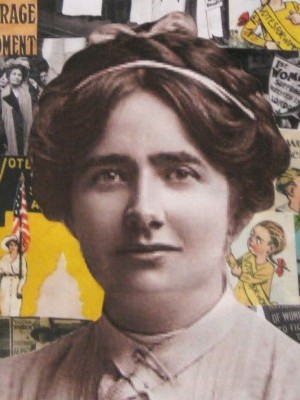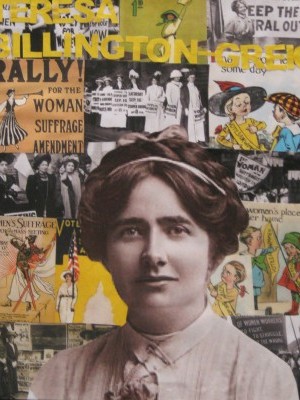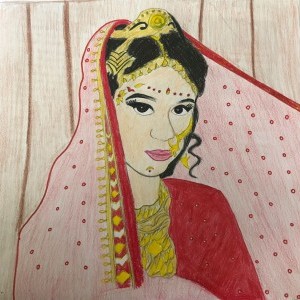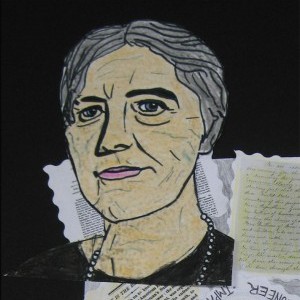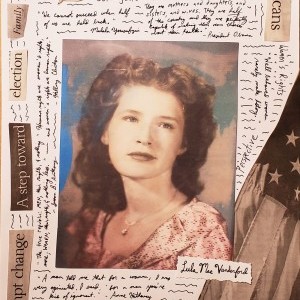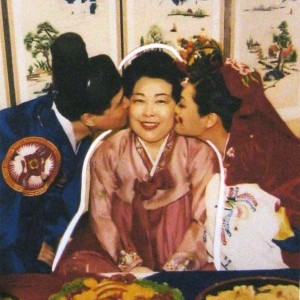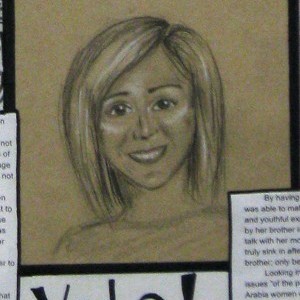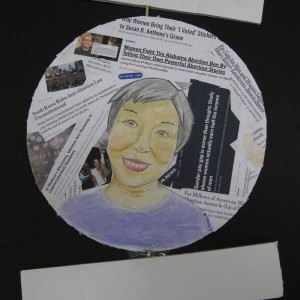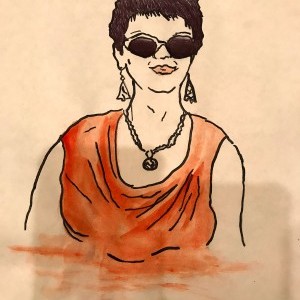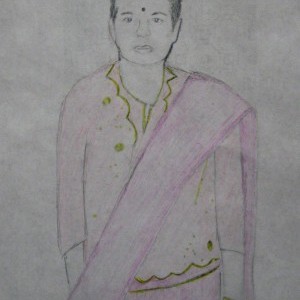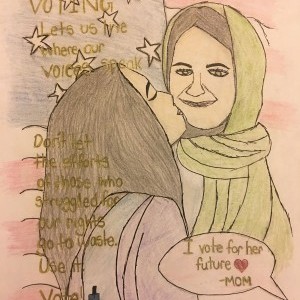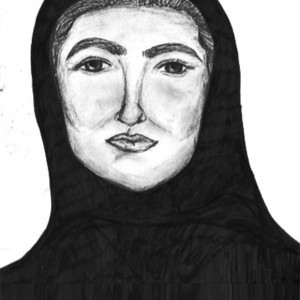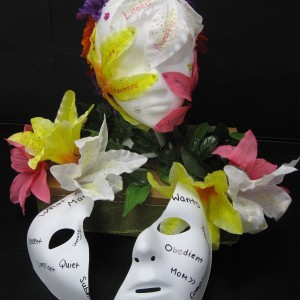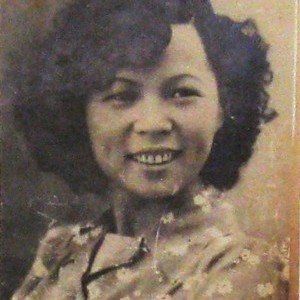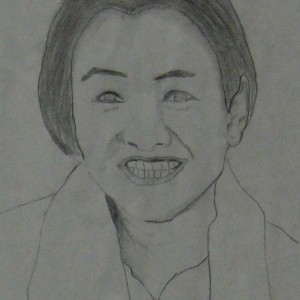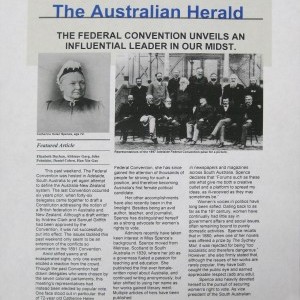Carly Hu, Jessica Lam, Maria Leyba, Rachel Matayev & Tri Watanasuparp
Townsend Harris High School | Flushing, NY | 11th Grade
Inspirational Family Member
Tsae-Sien Hu, My Grandmother
My grandmother, Tsae-Sien Hu, was the first woman in my family to be granted the right to vote. Though my grandmother now lives a comfortable and happy life, since her childhood, she had a very difficult home life. Her mother died when she was one, and she was raised by her step-grandmother and grandfather. In 1949, when she was 10 years old, she fled to Taiwan with her grandparents to escape the communist regime in China. At that point, her grandfather was the single source of economic support for her family, and he was diagnosed with cancer when she was in high school. Thus, my grandmother chose to prioritize her family, and firmly giving up the idea of going to college, began nursing school at a university in Taiwan. By doing this, she was able to have a free tuition, and could earn money for her family while still having some pocket money.
Many years later, my grandmother met my grandfather, whom she met through her neighbors. They emigrated to the United States with their two children –my aunt and father, both in elementary school at the time– with a green card in 1973. After about five years living in New York, my father’s family became United States citizens. Like most new immigrants, my grandparents focused on providing for the family above anything else at the time. While my grandfather worked for the postal service, my grandmother was able to achieve a highly respected position as a nurse at a hospital in Brooklyn, and was proud to be nominated as nurse-of-the-year after 30 years of work.
My grandmother was granted the right to vote when she became a US citizen, along with my grandfather. Though the two of them were not very knowledgeable about US politics and generally did not vote for smaller scale elections, my grandmother says that she did vote for presidential elections once she had the ability to. The first election she voted in was in 1980, and she has continued to vote in presidential elections since. On the other hand, my other grandmother (my mother’s mother) did not vote when she became a citizen around the same time. This is due to the fact that she does not know nearly as much English as my father’s mother, and knew even less at the time. Nonetheless, it is extremely interesting to consider that almost 40 years ago, a woman in my family was the first of many more to be able to participate in a US election.
Historical Figure I Admire
Teresa Billington-Creig
Born to a shipping clerk on October 15th, 1877 in Preston Lancashire, Teresa Billington-Greig was a British suffragette who helped advance the suffrage movement greatly. Growing up, Billington had conflicting views with those of her parents; while her parents were Roman Catholic, she held different beliefs in that she believed that girls deserved the right to a better education instead of simply staying at their desks all day without being taught the material. At this point, Billington, aged 17, ran away from Lancashire to her uncle’s where she trained to become (and eventually became) a teacher in Manchester.
When Billington became a teacher at Crumpsall, she refused to teach religious material which resulted in many threats of being fired which then resulted in Emmeline Pankhurst aiding Billington in being transferred to teach at a Jewish school where religion was not taught. Eventually Billington joined the Independent Labour Party and in 1904 she was appointed as the organizer of the party for Manchester. During this time, Billington also became involved with the trade union issues as she was appalled by the wage gap; eventually, she was able to become the secretary of the Manchester Equal Pay Committee.
Later on, in 1904, Billington was appointed by the Women’s Social and Political Union as a travelling speaker. A year later in 1905, Billington was asked to become a full-time organizer for the Independent Labour Party and with this, she became the second woman to be appointed such a position and the first woman to hold such power. In 1906, Billington was sent to Scotland to organize the WSPU. In 1907, many members, including Billington, left the Women’s Freedom League due to the organized democracy where Billington was originally appointed the Nation Honorary Organizing Secretary for the League. After joining the Women’s Social and Political Union, Billington was arrested and sent to Holloway Prison as the first Suffragette to be sent there. Later on that same year, she also married Frederick Lewis Greig, a billiard table manufacturer. In 1910, however, Billington resigned after the Women’s Freedom League defeated the Conciliation Bill. Following this, Billington continued to work, write, and give speeches. Her daughter, Fiona, was born in December 1915 and until 1937, her only organizational work was in sport. She then joined the WFL once again to work for its Electoral Committee and at this point, she continued working for the Women for Westminster group. From 1947 to 1951, she partook in the Conference on the Feminine Point of View. After every contribution she provided for the women’s rights movement, she died in 1964 in London.
What the Project Means to Me
During the early 1900’s, women in the United Kingdom had very few rights and political rights were definitely not included. Britain had a patriarchal society where women had to maintain traditional female roles. For example, they got married, took care of children, and dealt with the housework while their husbands worked and brought home money. If they were not married, however, women would work as waitresses, cooks, or in the general field of service. Overall, women were expected to follow the traditional traits of getting married, having children, and relying on their husbands to support them unless they were not married in which case they would work in the service industry.
During her time as a suffragette, Billington made many impacts through her writings about the suffrage movement. She wrote numerous biographies, some of which were used as obituaries while others were to support the women’s cause. In addition to biographies, she also wrote articles for numerous journals that greatly helped the movement and she often made the claim that every step along the road of the suffrage movement was essential towards their success. In some texts, she even recommended that suffragettes try new tactics aside from protesting, strikes, and boycotts.
Explore the Archive
More From This Class
Click on the thumbnails below to view each student's work.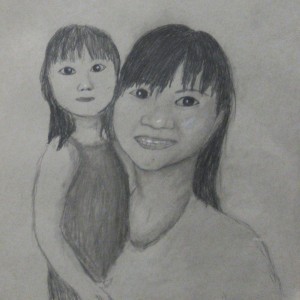
Vivian Chen, Josephine Chen, Ivan Chan, Zafirah Rahman, Neeharika Reddy, Daniel Shi, Daniel Shi, Jacqueline Cho & Osiris Guerrero

Jennifer Moran, Adebola Ademola, Julia Hong, Vicki Kanellopoulos, Inga Kulma, Maimunah Virk, Deborah Molina & Kailey Van
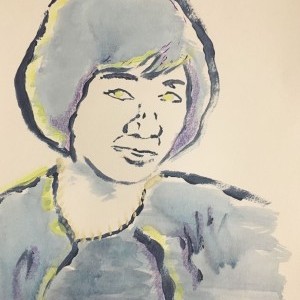
Kristina Chang, Sarah Chowdhury, Bethany Leung, Letian Fang, Cathy Choo, Kelly Chan, Emily Tan, Adamary Felipe & Kenney Son
Deadline Extended
There's still time to join Women Leading the Way.
Become a part of our storytelling archive. Enroll your class today.
Join the Project

